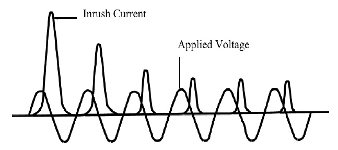Transformer Inrush Current
What is Transformer Inrush Current
Transformer inrush currents can be divided into three categories: energization inrush, recovery inrush, sympathetic inrush.
The first. energization inrush. results from the reapplication of system voltage to a transformer which has been previously deenergized. The second. recovery inrush, occurs when transformer voltage is restored after having been reduced by a nearby short circuit on the system. The third, sympathetic inrush, can occur
when two or more transformers are operated in parallel. Offsets in inrush currents can circulate in transformers already energized, which in turn causes a mild inrush. Energization inrush is the most commonly investigated form of inrush, and can result in the largest current magnitudes. To gain an analytical understanding of inrush. we must first understand the relationship between the voltage applied to the transformer winding and the flux in the transformer's magnetic core.

A transformer steel core's remanence means that it retains a static magnetic field when power is removed. When power is then reapplied, the residual field will cause a high inrush current until the effect of the remanent magnetism is reduced, usually after a few cycles of the applied alternating current. Overcurrent protection devices such as fuses must be selected to allow this harmless inrush to pass
When a transformer is livened, the magnetizing inrush currents are estimated as multiples of the transformer's kVA.
In addition, during the normal life of a transformer you can expect hot-load and cold-load pick-up events.
You must select transformer fusing that will not be damaged by these events.
Decay of inrush current depends on the series resistance of the transformer winding. In theoretical cases where the winding resistance is ignored, flux offset will never fall back to zero and inrush will persist. In a real transformer, winding resistance will damp out the inrush. It is difficult to consider the rate of decay using an L/R time constant, since the magnetization inductance involved is nonlinear. An approximation can be made by considering the time required for the inrush
current to decay to lie of the maximum peak value. Time constants for inrush can range from a few cycles up to maybe one minute, depending on the transformer's size and other design parameters.
Inrush currents are of special concern to relay applications engineers. Protection must be able to tell the difference between a temporary inrush and an actual short circuit. Fuses must be selected so that the current produced by inrush does~cause melting. Transformer differential relays usually contain a "harmonic
restraint" that filters out second harmonics, which are one of the main frequency components of inrush current. All transient simulations involving transformers (especially .inrush and ferro resonance) are only as accurate as the parameters given to the model. In the case of a single phase transformer, the saturation characteristic can be measured without too much difficulty - either from RMS (effective) V-I excitation measurements or more exact measurement of flux-current waveforms can be used. Good approximations of the saturation characteristic can also be made from core dimensions and B-H characteristics. if that information is available from the manufacturer.
In the case of three phase transformers, however, it is very difficult to measure the saturation characteristic of each phase. Due to non linearity and magnetic coupling between phases, use of superposition is not possible. As a rule. each of the currents is non-sinu8oidal, different in magnitude and distorted with
different harmonics. Added confusion is caused by manufacturer's open-circuit test reports which give the ~~~ RMS line current flowing into the three phases. There is also a great problem in developina proper models. The model must be different for each type of core configuration and winding connection.
- Go back to the previous page.
- Use the search bar at the top of the page to search for your products.
- Follow these links to get you back on track!
Store Home | My Account
 A transformer steel core's remanence means that it retains a static magnetic field when power is removed. When power is then reapplied, the residual field will cause a high inrush current until the effect of the remanent magnetism is reduced, usually after a few cycles of the applied alternating current. Overcurrent protection devices such as fuses must be selected to allow this harmless inrush to pass
When a transformer is livened, the magnetizing inrush currents are estimated as multiples of the transformer's kVA.
In addition, during the normal life of a transformer you can expect hot-load and cold-load pick-up events.
You must select transformer fusing that will not be damaged by these events.
Decay of inrush current depends on the series resistance of the transformer winding. In theoretical cases where the winding resistance is ignored, flux offset will never fall back to zero and inrush will persist. In a real transformer, winding resistance will damp out the inrush. It is difficult to consider the rate of decay using an L/R time constant, since the magnetization inductance involved is nonlinear. An approximation can be made by considering the time required for the inrush
current to decay to lie of the maximum peak value. Time constants for inrush can range from a few cycles up to maybe one minute, depending on the transformer's size and other design parameters.
Inrush currents are of special concern to relay applications engineers. Protection must be able to tell the difference between a temporary inrush and an actual short circuit. Fuses must be selected so that the current produced by inrush does~cause melting. Transformer differential relays usually contain a "harmonic
restraint" that filters out second harmonics, which are one of the main frequency components of inrush current. All transient simulations involving transformers (especially .inrush and ferro resonance) are only as accurate as the parameters given to the model. In the case of a single phase transformer, the saturation characteristic can be measured without too much difficulty - either from RMS (effective) V-I excitation measurements or more exact measurement of flux-current waveforms can be used. Good approximations of the saturation characteristic can also be made from core dimensions and B-H characteristics. if that information is available from the manufacturer.
In the case of three phase transformers, however, it is very difficult to measure the saturation characteristic of each phase. Due to non linearity and magnetic coupling between phases, use of superposition is not possible. As a rule. each of the currents is non-sinu8oidal, different in magnitude and distorted with
different harmonics. Added confusion is caused by manufacturer's open-circuit test reports which give the ~~~ RMS line current flowing into the three phases. There is also a great problem in developina proper models. The model must be different for each type of core configuration and winding connection.
A transformer steel core's remanence means that it retains a static magnetic field when power is removed. When power is then reapplied, the residual field will cause a high inrush current until the effect of the remanent magnetism is reduced, usually after a few cycles of the applied alternating current. Overcurrent protection devices such as fuses must be selected to allow this harmless inrush to pass
When a transformer is livened, the magnetizing inrush currents are estimated as multiples of the transformer's kVA.
In addition, during the normal life of a transformer you can expect hot-load and cold-load pick-up events.
You must select transformer fusing that will not be damaged by these events.
Decay of inrush current depends on the series resistance of the transformer winding. In theoretical cases where the winding resistance is ignored, flux offset will never fall back to zero and inrush will persist. In a real transformer, winding resistance will damp out the inrush. It is difficult to consider the rate of decay using an L/R time constant, since the magnetization inductance involved is nonlinear. An approximation can be made by considering the time required for the inrush
current to decay to lie of the maximum peak value. Time constants for inrush can range from a few cycles up to maybe one minute, depending on the transformer's size and other design parameters.
Inrush currents are of special concern to relay applications engineers. Protection must be able to tell the difference between a temporary inrush and an actual short circuit. Fuses must be selected so that the current produced by inrush does~cause melting. Transformer differential relays usually contain a "harmonic
restraint" that filters out second harmonics, which are one of the main frequency components of inrush current. All transient simulations involving transformers (especially .inrush and ferro resonance) are only as accurate as the parameters given to the model. In the case of a single phase transformer, the saturation characteristic can be measured without too much difficulty - either from RMS (effective) V-I excitation measurements or more exact measurement of flux-current waveforms can be used. Good approximations of the saturation characteristic can also be made from core dimensions and B-H characteristics. if that information is available from the manufacturer.
In the case of three phase transformers, however, it is very difficult to measure the saturation characteristic of each phase. Due to non linearity and magnetic coupling between phases, use of superposition is not possible. As a rule. each of the currents is non-sinu8oidal, different in magnitude and distorted with
different harmonics. Added confusion is caused by manufacturer's open-circuit test reports which give the ~~~ RMS line current flowing into the three phases. There is also a great problem in developina proper models. The model must be different for each type of core configuration and winding connection.

 United States
United States